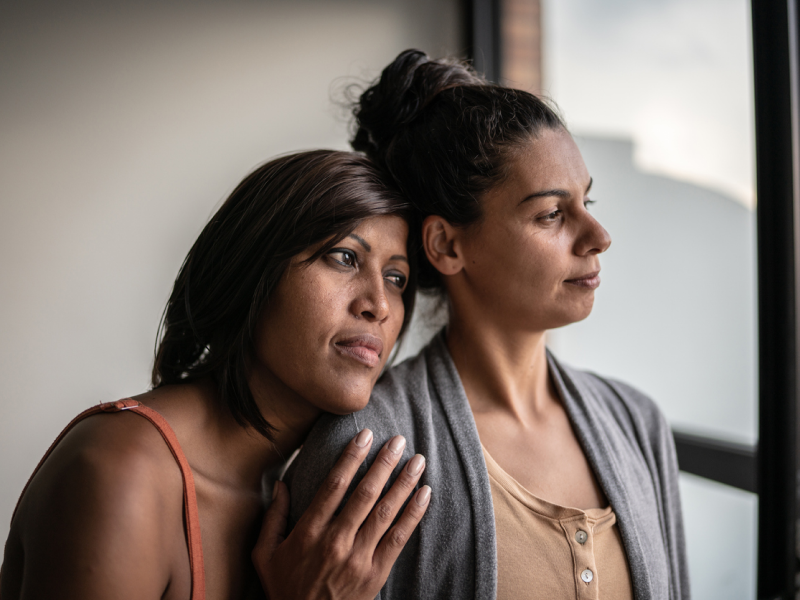
Table of Contents
How A Person Living With Bipolar Disorder Thinks, According to Experts

Written By: Sarah Fielding

Clinically Reviewed By: Clary Figueroa
August 9, 2024
6 min.
Experts share what a person living with bipolar disorder might be thinking as they experience the condition — from thoughts focused on overconfidence to negative self-perception and more.
Learn more about our Clinical Review Process
Table of Contents
Each person’s experience with mental health is unique, but there are patterns individuals with the same condition might exhibit. These similarities can also extend to how they think and respond to anything from triggers to day-to-day experiences. So, how does a person living with bipolar disorder think?
That’s a large group to speak for, as the National Alliance on Mental Illness (NAMI) reports that about 2.3% of people in the US receive a bipolar disorder diagnosis, with 83% of cases classified as severe. On average, it first presents in people at 25 years of age, but it can also occur in younger people. However, understanding the condition and its impact can paint a better picture of how people living with bipolar disorder might think and the ways their loved ones can support them. Below, experts share what a person living with bipolar disorder might be thinking as they experience the condition and what they can do to manage those thoughts.

We can help your loved one manage bipolar disorder
Virtual intensive therapy for serious mental health issues.
What is bipolar disorder?
Bipolar disorder is a mental health condition that causes unusual shifts in a person’s mood, energy, activity levels, and concentration. It can have overlapping symptoms with other mental health conditions (like an anxiety disorder or a depressive disorder), and it is sometimes mistakenly thought of as a personality disorder, but it is actually a type of mood disorder. There are two primary forms of bipolar disorder: type I and type II.
What is bipolar disorder I?
Bipolar I disorder is marked by manic episodes, which are periods of “abnormally elevated, expansive, or irritable mood lasting at least one week for most of the day,” according to Charlie Health Primary Therapist Meghan Jensen, LPC. A manic episode can include increased energy, activity, or restlessness, but in some instances, it may include risky behaviors that are severe enough to warrant medical attention or hospitalization, explains Clinical Supervisor Tracye Freeman Valentine, LPC-MHSP. A person living with bipolar I disorder might also experience depressive episodes that can last at least two weeks and include symptoms like fatigue, eating more or less, sleep disturbances, and more.
Bipolar disorder symptoms can change back and forth throughout the year. “A person may experience both manic and depressive episodes and rapid mood cycling, which is defined as four or more of the episodes in a year,” says Freeman Valentine. “The symptoms have moderate to severe functional impairment in day-to-day activities.”

What is bipolar II disorder?
Bipolar II disorder is a type of bipolar disorder that doesn’t include full-fledged mania episodes. Instead, it “consists of at least one depressive mood and one hypomania — a milder version of mania that lasts for a shorter time — episode,” says Freeman Valentine. “The symptoms are not full-blown and have less impairment with day-to-day activities.” Hypomanic symptoms include talkativeness, racing thoughts, increased energy, and more.
The depressive symptoms will present similarly to those experienced in bipolar I disorder, but the person might feel a persistent low mood and associated symptoms during a depressive episode, says Jensen. Hypomanic episodes last at least four days and, as explained, are less severe than their manic counterpart — though some symptoms are the same.
Potential thought patterns while living with bipolar disorder
It’s impossible to detail exactly what each person who lives with bipolar thinks. “People with bipolar disorder usually experience both depressive moods and times of excitement of high energy, reduced inhibitions, and less sleep. The range of experiences is vast,” explains Freeman Valentine. Personal experience, the current impact of the disorder, the help available, and more all impact how an individual living with bipolar thinks.
However, some general thought patterns can be associated with bipolar disorder, which can be beneficial to know for both people who experience it (no one wants to feel alone in it or misunderstood) and those hoping to support them. “For example, a person may participate in activities to the extreme like eating, drinking, or spending too much money when experiencing a period of high energy and excitement, which may lead to depression and anxiety due to actions and feeling the loss of equilibrium in mood due to the cycling between the moods,” adds Freeman Valentine. “During the phases, a person may also experience suicidal ideations or thoughts of self-harm.”
Jensen elaborates on this, explaining that thoughts during a manic or hypomanic episode could involve:
- Rapid and disjointed thoughts that make it difficult to focus
- Overconfidence and inflated self-esteem that leads to risky behaviors
- Irritability or agitation that can cause conflicts with others
- Perceived invincibility that might lead to unrealistic plans and goals
According to Jensen, depressive episodes, in contrast, can bring thoughts such as:
- Hopelessness and worthlessness
- Overall difficulty concentrating and making decisions
- Negative self-perception or guilt
- Suicidal ideation
If you’re experiencing suicidal thoughts or are in danger of harming yourself, this is a mental health emergency. Contact The Suicide & Crisis Lifeline 24/7 by calling or texting 988.
Coping with bipolar disorder thoughts and symptoms
Bipolar disorder can be a lifelong experience that requires care, attention, and understanding. The general symptoms brought on by bipolar I and bipolar II disorders can require a range of coping mechanisms. There are steps and habits a person can implement to manage the thoughts and actions associated with them. Here are the coping mechanisms Jensen and Freeman Valentine recommend trying.
1. Implement a routine
The mental health professionals recommend that individuals create structure and routines in many areas of their lives. These routines could include exercise, meditation, and calming activities like reading. Keeping a consistent sleep schedule (going to bed and waking up at the same time) is among the most important routines for someone with bipolar disorder because sleep disturbances can be among the first signs of a manic or depressive episode. By maintaining a consistent sleep schedule people can speak to a doctor or therapist if they notice a disturbance in their sleep and are worried about their mental health, the experts say.
2. Practice medication compliance
Medical professionals often prescribe medication to help people manage bipolar disorder symptoms. A person should do their best to take the recommended quantity of medication at the necessary frequency. This compliance can go a long way toward keeping symptoms in check.
3. Try psychoeducation and psychotherapy
A person living with bipolar disorder might want to explore options like cognitive behavioral therapy to identify their triggers, manage symptoms, incorporate grounding techniques, and learn additional coping techniques. “With therapy and psychoeducation, the person will have tools to identify symptoms of mania and depression, watch for patterns of the behavior, and identify triggers that influence mood changes,” says Freeman Valentine. “Psychoeducation and therapy are vital to manage and identify warning signs of an episode, involve supportive friends/family, and implement an emergency action plan.”
4. Get support from others
The people who love and support you should want to help you navigate bipolar disorder. “Having connections and a ‘circle of support’ is important and reduces isolation and increases interactions and feelings of support,” says Freeman Valentine. “It is important to understand that check-ins and a circle of support is not a weakness but a tool and a positive habit for managing the disorder.” It can be beneficial for individuals to involve their loved ones in any safety plan they create and make them aware of warning signs.
On that note, there are many ways a person can support those in their life who live with bipolar disorder. Psychoeducation about bipolar disorder is a valuable tool for support from friends and family. They can also assist in creating that routine, maintain non-judgemental communication, and be patient.

How Charlie Health can help
If you or a loved one are struggling with bipolar disorder, Charlie Health is here to help. Charlie Health’s virtual Intensive Outpatient Program (IOP) provides more than once-weekly mental health treatment for dealing with serious mental health conditions, including bipolar disorder and other mental disorders. Our expert clinicians incorporate evidence-based therapies into individual counseling, family therapy, and group sessions. With treatment, managing your well-being is possible. Fill out the form below or give us a call to start healing today.



